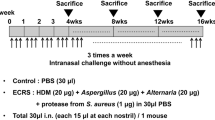Abstract
Allergic rhinitis (AR) has been a significant healthcare burden on individuals and society. However, the detailed effect of different patterns of allergen exposure on the development of AR remains controversial. A mouse model of AR was established to address the complex relationships between allergen exposure and the development of AR. Allergic symptom, OVA-specific IgE in serum and nasal lavage fluid, allergic inflammation in nasal tissues were evaluated after intranasal sensitization and challenge of ovalbumin (OVA) in mice treated with two different doses of allergen for different sensitized durations. Exposure to different doses and sensitized durations of OVA were capable of inducing allergic nasal response. Repetitive OVA exposure in the sensitization phase induced the recruitment of eosinophils and goblet cell hyperplasia. The level of OVA-specific IgE in serum depended on OVA exposure and was mediated in a duration-related manner. In addition, mice treated with low-dose OVA for prolonged duration manifested the major features of human local allergic rhinitis. There were dose- and duration-related effects of allergen exposure on the development of AR. LAR was associated with repetitive exposure to low-dose allergen. Thus, allergen avoidance should be an important aim of AR management.




Similar content being viewed by others
References
Brozek JL, Bousquet J, Baena-Cagnani CE, Bonini S, Canonica GW, Casale TB, van Wijk RG, Ohta K, Zuberbier T (2010) Allergic rhinitis and its impact on asthma (ARIA) guidelines: 2010 revision. J Allergy Clin Immunol 126:466–476
Asher MI, Montefort S, Björkstén B, Lai CK, Strachan DP, Weiland SK, Williams H (2006) Worldwide time trends in the prevalence of symptoms of asthma, allergic rhinoconjunctivitis, and eczema in childhood: ISAAC phases one and three repeat multicountry cross-sectional surveys. Lancet 368:733–743
Greiner AN, Hellings PW, Rotiroti G, Scadding GK (2011) Allergic rhinitis. Lancet 378:2112–2122
Galli SJ, Tsai M, Piliponsky AM (2008) The development of allergic inflammation. Nature 454:445–454
Illi S, von Mutius E, Lau S, Niggemann B, Grüber C, Wahn U (2006) Perennial allergen sensitisation early in life and chronic asthma in children: a birth cohort study. Lancet 368:763–770
Mills S, Siebers R, Wickens K, Crane J, Purdie G, Fitzharris P (2002) House dust mite allergen levels in individual bedding components in New Zealand. N Z Med J 115:151–153
Casas L, Sunyer J, Tischer C, Gehring U, Wickman M, Garcia-Esteban R, Lehmann I, Kull I, Reich A, Lau S, Wijga A, Antó JM, Nawrot TS, Heinrich J, Keil T, Torrent M (2015) Early-life house dust mite allergens, childhood mite sensitization, and respiratory outcomes. Allergy 70:820–827
Schram-Bijkerk D, Doekes G, Boeve M, Douwes J, Riedler J, Ublagger E, von Mutius E, Budde J, Pershagen G, van Hage M, Wickman M, Braun-Fahrländer C, Waser M, Brunekreef B, PARSIFAL study group (2006) Nonlinear relations between house dust mite allergen levels and mite sensitization in farm and nonfarm children. Allergy 61:640–647
Custovic A, Hallam CL, Simpson BM, Craven M, Simpson A, Woodcock A (2001) Decreased prevalence of sensitization to cats with high exposure to cat allergen. J Allergy Clin Immunol 108:537–539
Kumar RK, Herbert C, Foster PS (2008) The “classical” ovalbumin challenge model of asthma in mice. Curr Drug Targets 9:485–494
Salo PM, Calatroni A, Gergen PJ, Hoppin JA, Sever ML, Jaramillo R, Arbes SJ Jr, Zeldin DC (2011) Allergy-related outcomes in relation to serum IgE: results from the National Health and Nutrition Examination Survey 2005–2006. J Allergy Clin Immunol 127:1226–1235
Powe DG, Jagger C, Kleinjan A, Carney AS, Jenkins D, Jones NS (2003) ‘Entopy’: localized mucosal allergic disease in the absence of systemic responses for atopy. Clin Exp Allergy 33:1374–1379
Rondón C, Romero JJ, López S, Antúnez C, Martín-Casañez E, Torres MJ, Mayorga C, R-Pena R, Blanca M (2007) Local IgE production and positive nasal provocation test in patients with persistent nonallergic rhinitis. J Allergy Clin Immunol 119:899–905
Rondón C, Fernández J, López S, Campo P, Doña I, Torres MJ, Mayorga C, Blanca M (2009) Nasal inflammatory mediators and specific IgE production after nasal challenge with grass pollen in local allergic rhinitis. J Allergy Clin Immunol 124:1005–1011
López S, Rondón C, Torres MJ, Campo P, Canto G, Fernandez R, Garcia R, Martínez-Cañavate A, Blanca M (2010) Immediate and dual response to nasal challenge with Dermatophagoides pteronyssinus in local allergic rhinitis. Clin Exp Allergy 40:1007–1014
Rondón C, Campo P, Galindo L, Blanca-López N, Cassinello MS, Rodriguez-Bada JL, Torres MJ, Blanca M (2012) Prevalence and clinical relevance of local allergic rhinitis. Allergy 67:1282–1288
Rondón C, Blanca-López N, Aranda A, Herrera R, Rodriguez-Bada JL, Canto G, Mayorga C, Torres MJ, Campo P, Blanca M (2011) Local allergic rhinitis: allergen tolerance and immunologic changes after preseasonal immunotherapy with grass pollen. J Allergy Clin Immunol 127:1069–1071
Acknowledgments
This study was supported by grants from the Science and Technology Program of Guangdong, China (2013B021800112) and the National Natural Science Foundation of Guangdong, China (2014A030313106).
Author information
Authors and Affiliations
Corresponding author
Ethics declarations
Ethical standards
All procedures performed in this study were in accordance with the ethical standards of the Animal Ethical and Welfare Committee.
Fundings
This study was supported by grants from the Science and Technology Program of Guangdong, China (2013B021800112) and the National Natural Science Foundation of Guangdong, China (2014A030313106).
Conflict of interest
The authors declare that they have no conflict of interest.
Rights and permissions
About this article
Cite this article
Liang, MJ., Fu, QL., Jiang, HY. et al. Immune responses to different patterns of exposure to ovalbumin in a mouse model of allergic rhinitis. Eur Arch Otorhinolaryngol 273, 3783–3788 (2016). https://doi.org/10.1007/s00405-016-4128-9
Received:
Accepted:
Published:
Issue Date:
DOI: https://doi.org/10.1007/s00405-016-4128-9




